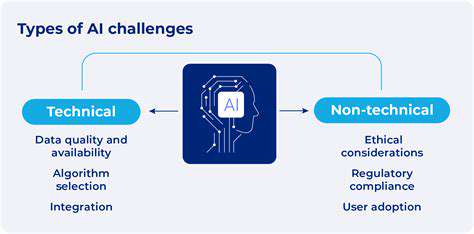
The Mechanism of CRISPR-Cas9
Imagine molecular scissors that can edit the blueprint of life itself. That's essentially what CRISPR-Cas9 does. This groundbreaking gene-editing technology borrows from nature's own defense mechanisms, allowing scientists to make precise changes to DNA sequences with unprecedented accuracy. The system works by combining two key components: a targeting mechanism and a cutting tool.
At the heart of this process lies the guide RNA (gRNA), which functions like a biological GPS, navigating the Cas9 enzyme directly to the exact spot in the genome that needs modification. When the target is located, Cas9 performs its precise cut, creating opportunities to repair, replace, or modify genetic information. This elegant simplicity belies its tremendous potential across countless applications in modern science.
Applications in Biotechnology
The implications of CRISPR technology extend far beyond laboratory experiments. Medical researchers are harnessing its power to develop potential cures for previously untreatable genetic disorders. Conditions like cystic fibrosis and sickle cell disease, once considered permanent genetic sentences, may soon become manageable through precise genetic corrections.
Agricultural scientists are equally excited, using CRISPR to develop crops that can withstand climate extremes while providing better nutrition. These advances couldn't come at a more critical time, as global populations grow and environmental challenges intensify. The technology also shows promise in creating new diagnostic methods for detecting pathogens quickly and accurately.
Ethical Considerations
With great power comes great responsibility, and CRISPR is no exception. The ability to rewrite genetic code raises profound questions about how far we should go in manipulating life's fundamental building blocks. Concerns range from unintended ecological consequences to the potential for creating genetic inequalities in human populations.
What's needed now is thoughtful, inclusive dialogue that brings together scientists, ethicists, policymakers, and the public. Only through such broad conversations can we establish guidelines that allow beneficial applications while preventing misuse. The stakes couldn't be higher when dealing with technology that could reshape the future of life on Earth.
Future Directions and Advancements
Researchers aren't resting on their laurels with the current CRISPR system. Teams worldwide are working on next-generation versions that offer even greater precision and fewer unintended effects. Some are developing alternative enzymes to Cas9 that might provide better control or different cutting patterns.
The most exciting frontier may be using CRISPR not just to cut DNA, but to make more subtle edits that don't break the genetic strand at all. Such refinements could open doors to treating complex conditions like Alzheimer's or Parkinson's by precisely adjusting gene activity rather than making permanent changes. The coming years will likely see CRISPR move from laboratory curiosity to clinical reality.
Addressing Delivery Challenges with AI

Optimizing Logistics for Timely Delivery
In today's fast-paced world, customers expect their packages yesterday. Meeting these expectations requires smart logistics that go beyond simple route planning. Modern systems analyze countless variables - from traffic patterns to weather forecasts - to ensure packages move efficiently from warehouse to doorstep.
The difference between satisfied customers and frustrated ones often comes down to visibility. When businesses implement comprehensive tracking systems, customers gain peace of mind knowing exactly where their package is and when it will arrive. This transparency transforms the delivery experience from a guessing game into a predictable process.
Improving Communication and Transparency
Nothing frustrates customers more than being left in the dark about their deliveries. Proactive communication builds trust and reduces support inquiries. The best systems don't just provide updates - they anticipate customer questions before they're asked.
Modern customers appreciate multiple communication channels, whether through text alerts, email updates, or interactive tracking portals. When delays do occur (as they inevitably will), prompt, honest communication can turn a negative situation into an opportunity to demonstrate excellent customer service.
Leveraging Technology for Enhanced Efficiency
The delivery industry is undergoing a technological revolution. Automated sorting systems can process thousands of packages per hour with near-perfect accuracy. Smart routing algorithms constantly adjust to changing conditions, finding the most efficient paths in real time.
These innovations don't just speed up deliveries - they also reduce environmental impact by minimizing unnecessary mileage. As fuel costs rise and environmental concerns grow, these efficiency gains become increasingly valuable for both businesses and the planet.
Addressing Potential Roadblocks and Delays
Even the best-planned deliveries can encounter unexpected obstacles. The mark of a resilient delivery system isn't the absence of problems, but how quickly and effectively it responds when issues arise. Forward-thinking companies maintain flexible networks that can adapt to disruptions.
Having backup plans for common scenarios (like severe weather or vehicle breakdowns) separates reliable carriers from the rest. Equally important is empowering customer service teams to resolve issues quickly, turning potential frustrations into positive experiences.
Implementing Robust Quality Control Measures
Delivery isn't complete until the package arrives in perfect condition. Comprehensive quality programs monitor every touchpoint, from warehouse handling to final delivery. Regular training ensures all staff understand proper procedures for fragile or sensitive items.
Smart packaging solutions can help protect contents while minimizing weight and size. Some companies now use sensors to monitor packages in transit, alerting handlers to potential damage risks before they become problems. This proactive approach to quality builds customer confidence and reduces costly returns.
Ensuring Customer Satisfaction and Building Trust
In the delivery business, trust is the ultimate currency. Customers who have positive experiences become loyal advocates, while negative experiences can spread quickly through social media. The most successful companies treat every delivery as an opportunity to strengthen their relationship with the customer.
Listening to customer feedback - both positive and negative - provides invaluable insights for continuous improvement. When businesses demonstrate they value their customers' opinions and act on their suggestions, they create powerful bonds that withstand occasional inevitable hiccups in the delivery process.

